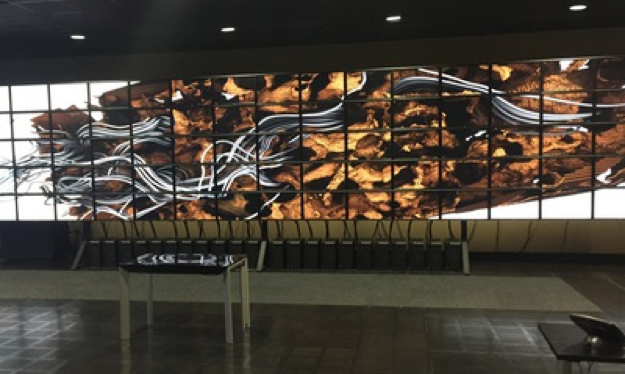This guest post from Intel explores how and why CPU-based interactive, photorealistic rendering is being increasingly adopted by the cloud computing community and enterprises across a wide spectrum of sectors.

OSPRay parallel rendering on TACC’s 328 Megapixel Stallion Tiled Display.
CPU-based interactive and photorealistic rendering via SDVis (Software Defined Visualization) with the open source Intel® Rendering Framework is supplanting GPUs in many modern HPC supercomputing centers. The ability to run and visualize anywhere with SDVis solutions, regardless of the scale of the visualization task and without requiring specialized hardware for interactive response, is the reason HPC centers no longer need to procure GPUs for visualization clusters.
The advantages of SDVis in the HPC community has not been lost on consumers of professional visualization focus products, which is why Autodesk’s VRED* 3D visualization and virtual prototyping software utilizes CPU-based ray traced rendering with SDVis while other leading software vendors such as Altair, Eastern Graphics, Kitware, and SURVICE Engineering Company are incorporating SDVis.[i]
SDVis unlocks the full power of a compute node for visual analysis,” Dan Stanzione, Executive Director of the Texas Advanced Computing Center (TACC) observes. “With it, even a single node becomes a powerful platform for analysis, as the full system memory is available to hold data.”
In particular, the TACC Frontera supercomputer, which will become the fastest academic supercomputer in the United States when it becomes operational in 2019, will rely on CPUs for visualization. “CPU-based SDVis will be our primary visual analysis mode on Frontera, leveraging the Intel® Rendering Framework stack,” according to Paul Navrátil, Director of Visualization at TACC.
The Frontera design makes the switch from GPUs to CPUs for visualization concrete. Frontera includes a GPU subsystem, but one that is designed to primarily support compute codes that leverage single- and half-precision operations, particularly molecular dynamics (MD) codes and various machine learning stacks.
The “visualize anywhere” nature of SDVis means that visualizing locally or remotely is possible on devices that can display from memory with no GPU acceleration required. For researchers who want to enable visualization on supercomputers which are CPU-based, Intel Rendering Framework enabled applications are ideal.
CPU-based SDVis will be our primary visual analysis mode on Frontera, leveraging the Intel Rendering Framework stack,” said Paul Navrátil, Director of Visualization at the Texas Advanced Computing Center (TACC).
Extraordinary display flexibility without device dependencies makes “visualize anywhere” even better. HPC users appreciate how they can view results on their laptops and switch to display walls or a cave. Professional visualization users literally see the same benefits regardless if they are rendering on an institutional cluster or in the cloud.
Simply by switching rendering backends, popular visualization tools in the HPC community such as VisIt* and ParaView* make it simple to switch between or even combine triangle-based OpenGL* rendering with Intel® OpenSWR and photorealistic ray-traced rendering with Intel® OSPRay. Jim Jeffers (Senior Director and Senior Principle Engineer, Intel Visualization Solutions) notes that the interactive performance delivered by the Intel Rendering Framework and SDVis “addresses the need and creates the want” for photorealistic rendering. Succinctly, interactive ray tracing with its inherent lighting capability lets scientists get more from their data. Again, this message has not been lost on the professional rendering community like movie studios and CAD/CAM software applications.
Trillion triangle OpenGL hero runs performed by Kitware[ii] and the use of in-situ and in-transit techniques to render both OpenGL and ray-traced images demonstrate how SDVis is redefining how scientists use visualization for peta- and exascale sized research efforts. In-situ simulation means that the rendering occurs on the same nodes that perform the computation. This is the reason why Jim Jeffers states, “A picture is worth an exabyte,” as no data movement is required! Of course, the in-situ technique benefits commercial software vendors as well.
Navrátil notes, “We expect in-situ workflows to become increasingly necessary on Frontera and across all large-scale simulation science.” Pointing to the future he states, “In-transit analysis will also play an increasing role as simulations improve support for loosely-coupled in situ frameworks. With an in-transit pathway, the simulation resources do not need to be shared for analysis tasks, which is favorable when analysis is compute-intensive, or when the simulation requires all available resources itself.”
The cross-market appeal of SDVis is clear as Jeffers observes when describing the success of SDVis and the Intel Rendering Framework: “There is a real pull from submarkets like CAD and automotive. Photorealism is extremely important in improving ‘virtual’ vehicle design and manufacturing from commercial airplanes to military vehicles. Meanwhile, there is increasing pull from adjunct markets that include offline and interactive rendering for animation and photoreal visual effects.”
Intel makes it easier for organizations to experience the benefit of SDVis with the Intel® Select Solutions for Professional Visualization that bring the right hardware and software to your organization through verified solutions that combine Intel® Xeon® Scalable processors with other technologies such as Intel® Omni-Path Architecture, Intel® SSDs, and the OpenHPC cluster software stack. Customers get the benefit of Intel’s latest compute, fabric, memory, storage, and software technologies without the need to perform lengthy research to determine the right hardware for visualization. Instead, they are able to rely on solutions that are already optimized for professional visualization.
Learn more about Intel Rendering Framework or check into the Intel® Select Solution for Professional Visualization.
[i] https://itpeernetwork.intel.com/anyscale-visualization-intel-select-solutions/
[ii] http://www.techenablement.com/third-party-use-cases-illustrate-the-success-of-cpu-based-visualization/
© Intel Corporation.
Intel, the Intel logo and Xeon are trademarks of Intel Corporation in the U.S. and/or other countries.
*Other names and brands may be claimed as the property of others.



